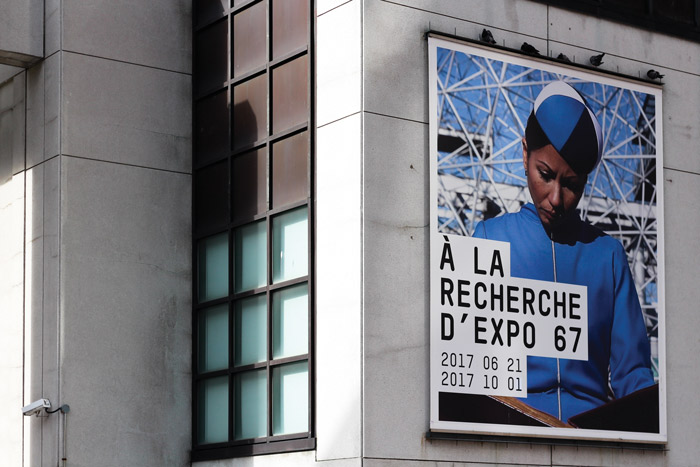The Montreal Museum of Contemporary Art (MAC) has opened up its doors for spectators to explore the world of Montreal’s proudest moment on the international stage (sorry 1976 Olympics). In Search of Expo 67 takes us back 50 years to a booming Montreal; a city welcoming the world’s fair during a period of progress and tensions, which were thematically addressed in the exhibit. Visitors are invited to dive into the universe of Expo 67 through a combination of movies, interactive pieces, music, and photographs. The 19 participating artists created unique pieces to commemorate the occasion, exploring themes of peace, acceptance, and tolerance.
“Man and His World” is the main theme of the exhibit. Inspired by the book/Wind, Sand, and Stars by Antoine de St Exupéry, it immediately captures a visitor’s attention upon entering the first room. A wall-sized screen transports spectators along the path of the ancient minirail that brought millions of visitors to the fair in 1967, with the anachronistic landscapes of 2017 unfolding before them. Accompanied by a voice reading the aforementioned book by St Exupéry, dating back to 1939, this is the first of many temporal contrasts the exhibit presents.
The journey then continues to different rooms showcasing films, each displaying a new perspective on Expo 67. On one side of the hallway, Geronimo Inutig’s Katimakainnarivugut, and Jean Pierre Aubé’s Kaleidoscope II, present different artistic approaches to the Canadian Pavilion and the Kaleidoscope Pavilion, two of the buildings edified for the occasion by the countries present at Expo 67. On the other side of the corridor, more serious pieces such as Emmanuelle Leonard’s Le Huitième Jour concentrate on the post-war political climate of the time and Cold War tensions persisting between the USSR and the US. This juxtaposition creates yet again an interesting contrast between these tensions and the Expo’s theme: Global unity after a long period of decolonization. Right before the exit, there is a change in the tonal setting—the visitor is transported to a room with flashy colors looking ahead to the Montreal of the 70s. A vinyl player adds to this atmosphere with music from the beginning of the electro era; a genre that is now so characteristic of the Montreal musical scene.
Although this last piece brings some variety to the overall exhibit, diversity in the art pieces is what lacks the most as the visitor walks through it. The visitors feel lost among the chaotic audio-visual pieces, distracting from the more traditional static mediums. The haphazard inclusion of historical information can prove chaotic and confusing, although perhaps it can be justified in reminiscence of the atmosphere at Expo 67.
While the exhibit does deliver an informative experience about Montreal history, unfortunately, exiting the MAC doors, some may feel like they haven’t really been in a museum of contemporary art, as the variety of artistic items used for the expo was very minimal throughout. In Search of Expo 67 provides an intriguing lens for its historical moment, but not quite an artistically-rich journey through the museum.








